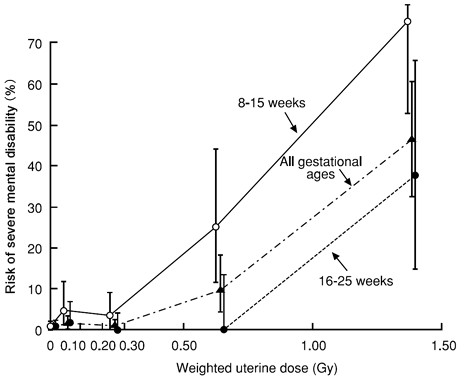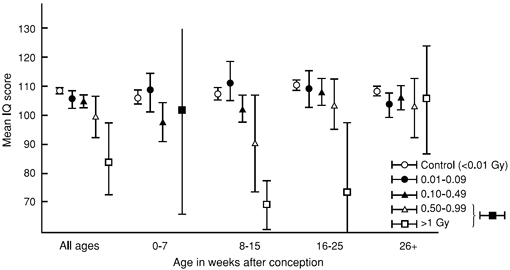Mental Disability and Growth Impairment among Survivors Exposed In Utero
By the late 1950s, exposure-related increases in small head size and mental disability were noted in persons exposed to radiation in utero. Severe mental disability has been diagnosed in 21 of 476 in utero survivors (4.4%) whose doses were 0.005 Gy or greater compared with nine of 1,068 (0.8%) whose doses were below 0.005 Gy. The prevalence was strongly associated with radiation dose and gestational age (i.e., particular developmental stages) ATB. Excess mental disability was especially pronounced in persons exposed at 8 to 15 weeks after conception, and to a lesser extent among those exposed at 16-25 weeks, but no excess was seen after exposure at 0-7 weeks or 26-40 weeks after conception (Figure 1). Dose-related decreases in school performance and IQ scores also were observed among the 8-25 week groups of in utero survivors, after excluding severely mentally disabled children (Figure 2), and increased seizure disorders were also evident in those groups.

Figure 1. Severe mental disability by radiation dose and gestational age among A-bomb survivors exposed in utero

Figure 2. Mean IQ scores and 95% confidence limits by uterine radiation dose (DS86) and gestational age among A-bomb survivors exposed in utero
Magnetic resonance imaging scans of the brains of six severely disabled in utero survivors suggest that radiation exposure during the third and fourth months of pregnancy may result in distinctive physical abnormalities in brain structure. As in persons exposed as children, annual body measurements of survivors exposed in utero have demonstrated an overall reduction in adult height and weight by age 18 in the high-dose group. These effects do not differ by sex or gestational age ATB.

